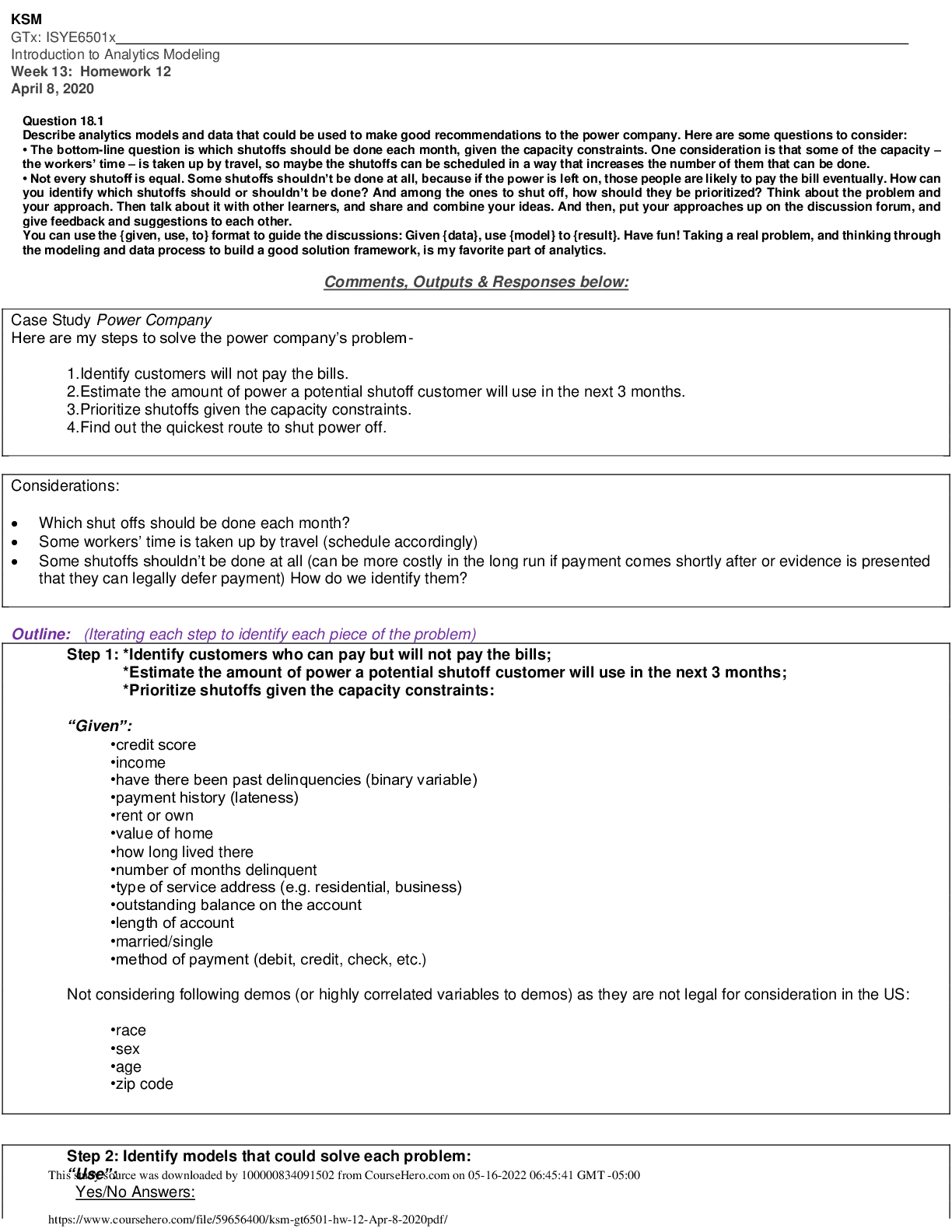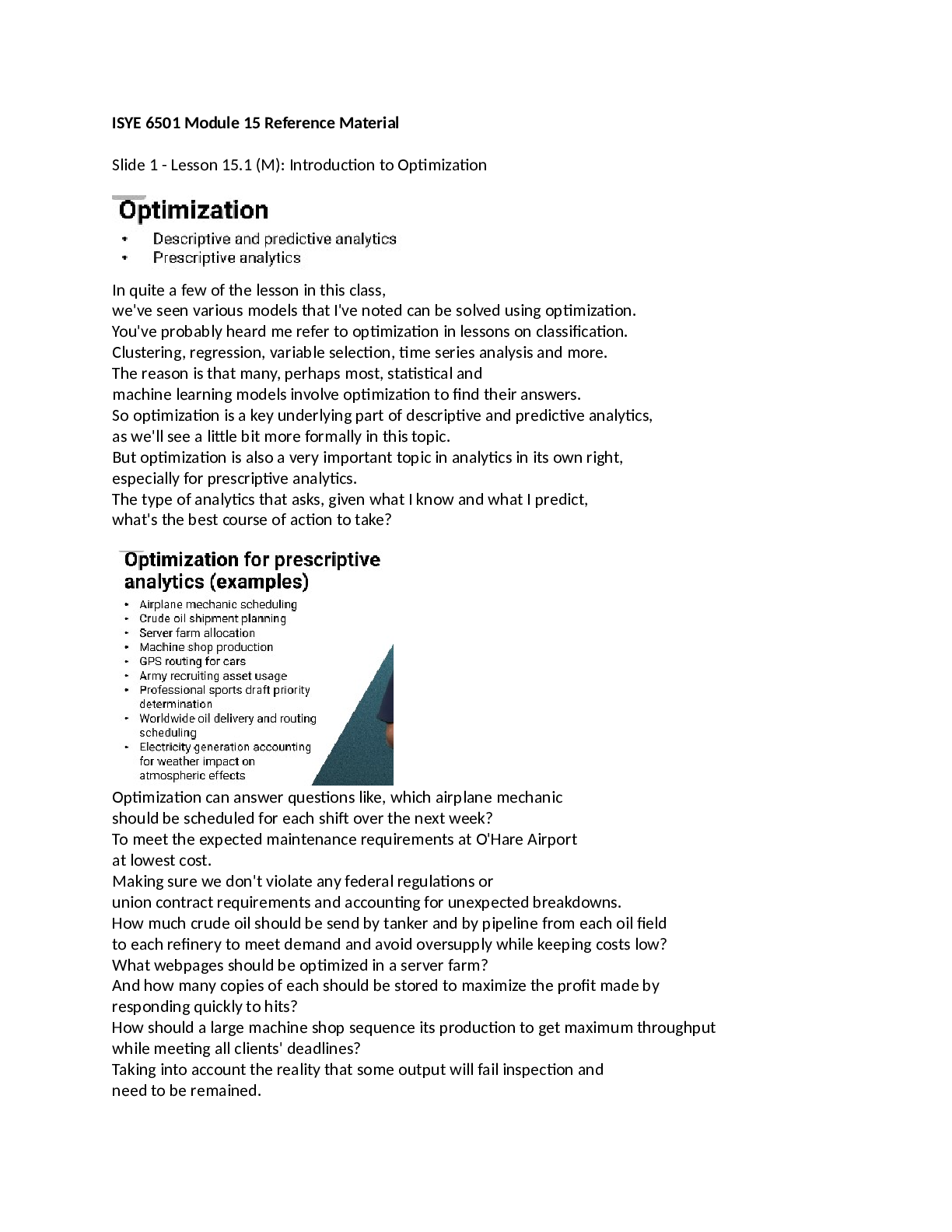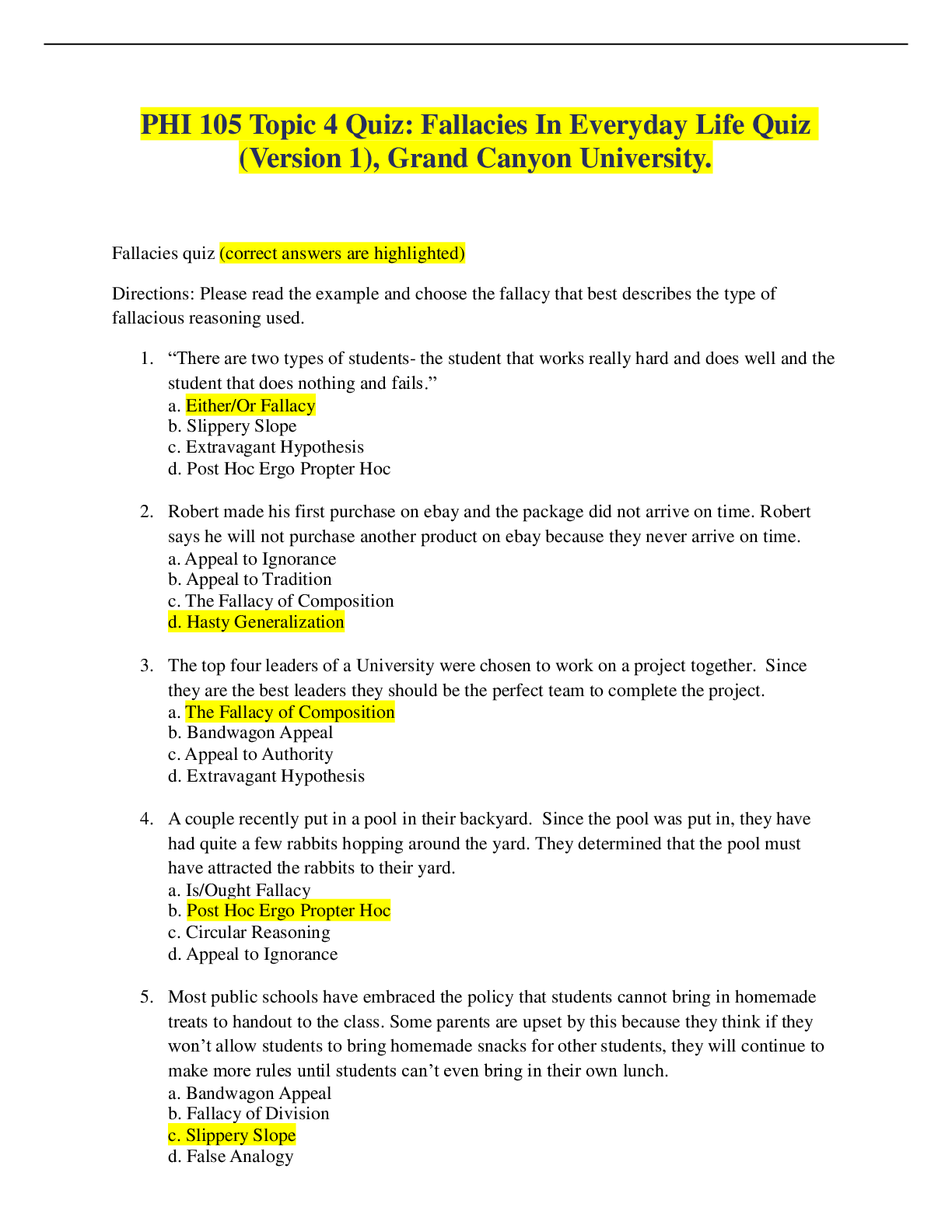Engineering > QUESTIONS & ANSWERS > KSM GTx: ISYE6501x Introduction to Analytics Modeling Week 13: Homework 12 (All)
KSM GTx: ISYE6501x Introduction to Analytics Modeling Week 13: Homework 12
Document Content and Description Below
KSM GTx: ISYE6501x Introduction to Analytics Modeling Week 13: Homework 12 April 8, 2020 Question 18.1 Describe analytics models and data that could be used to make good recommendations to the p... ower company. Here are some questions to consider: • The bottom-line question is which shutoffs should be done each month, given the capacity constraints. One consideration is that some of the capacity – the workers’ time – is taken up by travel, so maybe the shutoffs can be scheduled in a way that increases the number of them that can be done. • Not every shutoff is equal. Some shutoffs shouldn’t be done at all, because if the power is left on, those people are likely to pay the bill eventually. How can you identify which shutoffs should or shouldn’t be done? And among the ones to shut off, how should they be prioritized? Think about the problem and your approach. Then talk about it with other learners, and share and combine your ideas. And then, put your approaches up on the discussion forum, and give feedback and suggestions to each other. You can use the {given, use, to} format to guide the discussions: Given {data}, use {model} to {result}. Have fun! Taking a real problem, and thinking through the modeling and data process to build a good solution framework, is my favorite part of analytics. Comments, Outputs & Responses below: Case Study Power Company Here are my steps to solve the power company’s problem1.Identify customers will not pay the bills. 2.Estimate the amount of power a potential shutoff customer will use in the next 3 months. 3.Prioritize shutoffs given the capacity constraints. 4.Find out the quickest route to shut power off. Considerations: • Which shut offs should be done each month? • Some workers’ time is taken up by travel (schedule accordingly) • Some shutoffs shouldn’t be done at all (can be more costly in the long run if payment comes shortly after or evidence is presented that they can legally defer payment) How do we identify them? Outline: (Iterating each step to identify each piece of the problem) Step 1: *Identify customers who can pay but will not pay the bills; *Estimate the amount of power a potential shutoff customer will use in the next 3 months; *Prioritize shutoffs given the capacity constraints: “Given”: •credit score •income •have there been past delinquencies (binary variable) •payment history (lateness) •rent or own •value of home •how long lived there •number of months delinquent •type of service address (e.g. residential, business) •outstanding balance on the account •length of account •married/single •method of payment (debit, credit, check, etc.) Not considering following demos (or highly correlated variables to demos) as they are not legal for consideration in the US: •race •sex •age •zip code Step 2: Identify models that could solve each problem: “Use”: Yes/No Answers: This study source was downloaded by 100000834091502 from CourseHero.com on 05-16-2022 06:45:41 GMT -05:00 https://www.coursehero.com/file/59656400/ksm-gt6501-hw-12-Apr-8-2020pdf/ •Classification (SVM or KNN) •Pay •Can pay but do not pay •Not able to pay •Clustering Problem of Payment: •Logistical Regression •Single-model Approach or Tree-based approach •Hybrid approach •first cluster •analyze each cluster separately Model Types Pros/Cons: Unsupervised Approach: Clustering Pros: Quick Cons: Not exact Clusters you would expect Supervised Approach: Classification/Logistical Regression Pros: Clear Decisions Cons: Requires clear thresholds Time series (only need a single month’s history) Pros: Good enough for past customer usage data Cons: Effective only for short-term forecasts Factor-based regression (if there is not a lot of past usage data): Pros: Can be effective even when there is not much specific customer data Cons: Need to normalize to account for seasonality Step 3/4: Identify the most efficient response to the problem: “To”: Using optimization and simulation can identify: The highest value set of customers for power shutoffs Identify locations, drive times, shut off times Identify how many additional workers are needed to complete the shutoffs Response: Step 1: Identify customers who can pay but will not pay the bills: “Given”: •credit score •income •have there been past delinquencies (binary variable) •payment history (lateness) •rent or own •value of home •how long lived there •number of months delinquent •type of service address (e.g. residential, business) •outstanding balance on the account •length of account •married/single •method of payment (debit, credit, check, etc.) Not considering following demos (or highly correlated variables to demos) as they are not legal for consideration in the US: This study source was downloaded by 100000834091502 from CourseHero.com on 05-16-2022 06:45:41 GMT -05:00 https://www.coursehero.com/file/59656400/ksm-gt6501-hw-12-Apr-8-2020pdf/ •race •sex •age •zip code “Use”: KNN (K-nearest neighbors) “To”: Identify customers who could pay but who [Show More]
Last updated: 1 year ago
Preview 1 out of 4 pages

Reviews( 0 )
Document information
Connected school, study & course
About the document
Uploaded On
May 19, 2022
Number of pages
4
Written in
Additional information
This document has been written for:
Uploaded
May 19, 2022
Downloads
0
Views
84


.png)
.png)
.png)
.png)
.png)
.png)


















.png)

